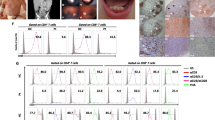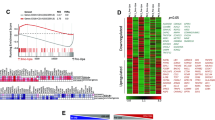Abstract
Rheumatoid arthritis (RA) is a chronic autoimmune disorder. Earlier studies have demonstrated that regulatory T (Treg) cells, the main cell type mediating immune tolerance, appeared to be enriched in the inflamed synovial tissues. It is still unclear why the Treg cells in RA patients are unable to limit exacerbated inflammation. Here, we found that the frequency of Tim3+Foxp3+ Treg cells, which were potent suppressors of proinflammatory responses, was downregulated in RA patients. Reduction in Tim3+Foxp3+ Treg frequency was correlated with increased RA disease activity. Furthermore, we observed that Tim3+Foxp3+ Tregs were expressed more interleukin (IL)-10 than Tim3−Foxp3+ Tregs. CD4+CD25+Tim3+ T cells had higher capability of inhibiting interferon (IFN)-γ and tumor necrosis factor (TNF)-α secretion from T cells and peripheral blood mononuclear cells (PBMCs) than CD4+CD25+Tim3− T cells. Compared to that in healthy individuals, CD4+CD25+ T cells in RA patients were less potent in suppressing IFN-γ and TNF-α production from PBMCs. Blocking Tim3 on CD4+CD25+ T cells from healthy controls resulted in an elevation of IFN-γ and TNF-α production from PBMCs, suggesting that Tim3 expression on CD4+CD25+ T cells was required for optimal Treg function. However, this phenomenon was not observed in RA patients. In conclusion, our study suggested that the CD4+CD25+Foxp3+ Treg cells from RA patients demonstrated a reduction of Tim3 and were less functional than Treg cells from healthy controls in a Tim3-related manner.




Similar content being viewed by others
References
McInnes, Iain B., and Georg Schett. 2011. The pathogenesis of rheumatoid arthritis. The New England Journal of Medicine 365: 2205–2219. doi:10.1056/NEJMra1004965.
Shevach, Ethan M. 2009. Mechanisms of Foxp3+ T regulatory cell-mediated suppression. Immunity. doi:10.1016/j.immuni.2009.04.010.
Rosser, Elizabeth C., and Claudia Mauri. 2015. Regulatory B cells: origin, phenotype, and function. Immunity 42: 607–612. doi:10.1016/j.immuni.2015.04.005.
Shevach, Ethan M., and Angela M. Thornton. 2014. tTregs, pTregs, and iTregs: similarities and differences. Immunological Reviews 259: 88–102. doi:10.1111/imr.12160.
Van Amelsfort, J.M., K.M. Jacobs, J.W. Bijlsma, F.P. Lafeber, and L.S. Taams. 2004. CD4+CD25+ regulatory T cells in rheumatoid arthritis: differences in the presence, phenotype, and function between peripheral blood and synovial fluid. Arthritis and Rheumatism 50: 2775–2785. doi:10.1002/art.20499.
Jiao, Z., W. Wang, R. Jia, J. Li, H. You, L. Chen, and Y. Wang. 2007. Accumulation of FoxP3-expressing CD4 + CD25 + T cells with distinct chemokine receptors in synovial fluid of patients with active rheumatoid arthritis. Scandinavian Journal of Rheumatology 36: 428–433. doi:10.1080/03009740701482800.
Moradi, Babak, Philipp Schnatzer, Sébastien Hagmann, Nils Rosshirt, Tobias Gotterbarm, Jan Philippe Kretzer, Marc Thomsen, Hanns-Martin Lorenz, Felix Zeifang, and Theresa Tretter. 2014. CD4+CD25+/highCD127low/− regulatory T cells are enriched in rheumatoid arthritis and osteoarthritis joints—analysis of frequency and phenotype in synovial membrane, synovial fluid and peripheral blood. Arthritis Research & Therapy 16: R97. doi:10.1186/ar4545.
Raghavan, S., D. Cao, M. Widhe, K. Roth, J. Herrath, M. Engstrom, G. Roncador, et al. 2009. FOXP3 expression in blood, synovial fluid and synovial tissue during inflammatory arthritis and intra-articular corticosteroid treatment. Annals of the Rheumatic Diseases 68: 1908–1915. doi:10.1136/ard.2008.100768.
XQ, E., H.X. Meng, Y. Cao, S.Q. Zhang, Z.G. Bi, and M. Yamakawa. 2012. Distribution of regulatory T cells and interaction with dendritic cells in the synovium of rheumatoid arthritis. Scandinavian Journal of Rheumatology 41: 413–420. doi:10.3109/03009742.2012.696135.
Zhu, Chen, Ana C. Anderson, Anna Schubart, Huabao Xiong, Jaime Imitola, Samia J. Khoury, Xin Xiao Zheng, Terry B. Strom, and Vijay K. Kuchroo. 2005. The Tim-3 ligand galectin-9 negatively regulates T helper type 1 immunity. Nature Immunology 6: 1245–1252. doi:10.1038/ni1271.
Monney, Laurent, Catherine A. Sabatos, Jason L. Gaglia, Akemi Ryu, Hanspeter Waldner, Tatyana Chernova, Stephen Manning, et al. 2002. Th1-specific cell surface protein Tim-3 regulates macrophage activation and severity of an autoimmune disease. Nature 415: 536–541. doi:10.1038/415536a.
McMahan, Rachel H, Lucy Golden-Mason, Michael I Nishimura, Brian J McMahon, Michael Kemper, Todd M Allen, David R Gretch, and Hugo R Rosen. 2010. Tim-3 expression on PD-1+ HCV-specific human CTLs is associated with viral persistence, and its blockade restores hepatocyte-directed in vitro cytotoxicity. The Journal of clinical investigation 120. American Society for Clinical Investigation: 4546–57. doi:10.1172/JCI43127.
Jones, R. Brad, Lishomwa C. Ndhlovu, Jason D. Barbour, Prameet M. Sheth, Aashish R. Jha, Brian R. Long, Jessica C. Wong, et al. 2008. Tim-3 expression defines a novel population of dysfunctional T cells with highly elevated frequencies in progressive HIV-1 infection. The Journal of Experimental Medicine 205: 2763–2779. doi:10.1084/jem.20081398.
Moorman, J.P., J.M. Wang, Y. Zhang, X.J. Ji, C.J. Ma, X.Y. Wu, Z.S. Jia, K.S. Wang, and Z.Q. Yao. 2012. Tim-3 pathway controls regulatory and effector T cell balance during hepatitis C virus infection. Journal of Immunology 189: 755–766. doi:10.4049/jimmunol.1200162.
Gao, Xin, Yibei Zhu, Gang Li, Haitao Huang, Guangbo Zhang, Fengming Wang, Jing Sun, et al. 2012. TIM-3 expression characterizes regulatory T cells in tumor tissues and is associated with lung cancer progression. Edited by Michael P. Bachmann. PLoS ONE 7. Public Library of Science: e30676. doi:10.1371/journal.pone.0030676.
Sakuishi, Kaori, Shin Foong Ngiow, Jenna M. Sullivan, Michele W.L. Teng, Vijay K. Kuchroo, Mark J. Smyth, and Ana C. Anderson. 2013. TIM3(+)FOXP3(+) regulatory T cells are tissue-specific promoters of T-cell dysfunction in cancer. Oncoimmunology 2: e23849. doi:10.4161/onci.23849.
Gautron, Anne-Sophie, and Margarita Dominguez-Villar. Marine de Marcken, and David a Hafler. 2014. Enhanced suppressor function of TIM-3(+) FoxP3(+) regulatory T cells. European Journal of Immunology: 1–9. doi:10.1002/eji.201344392.
Arnett, Frank C., Steven M. Edworthy, Daniel A. Bloch, Dennis J. McShane, James F. Fries, Norman S. Cooper, Louis A. Healey, Stephen R. Kaplan, Matthew H. Liang, and Harvinder S. Luthra. 1988. The American Rheumatism Association 1987 revised criteria for the classification of rheumatoid arthritis. Arthritis and Rheumatism 31: 315–324. doi:10.2169/naika.77.742.
Akimova, Tatiana, Ulf H. Beier, Liqing Wang, Matthew H. Levine, and Wayne W. Hancock. 2011. Helios expression is a marker of T cell activation and proliferation. Edited by Carmen Molina-Paris. PLoS ONE 6. Public Library of Science: e24226. doi:10.1371/journal.pone.0024226.
Elkord, Eyad, May Abd Al Samid, and Belal Chaudhary. 2015. Helios, and not FoxP3, is the marker of activated Tregs expressing GARP/LAP. Oncotarget 6. Impact Journals, LLC: 20026–36. Doi:10.18632/oncotarget.4771.
Takatori, Hiroaki, Hirotoshi Kawashima, Ayako Matsuki, Kazuyuki Meguro, Shigeru Tanaka, Taro Iwamoto, Yoshie Sanayama, et al. 2015. Helios enhances Treg cell function in cooperation with FoxP3. Arthritis & Rheumatology 67: 1491–1502. doi:10.1002/art.39091.
Li, Shufeng, Dayong Peng, Yeteng He, Zhang Hu, Huaqiang Sun, Shiying Shan, Yuanlin Song, et al. 2014. Expression of TIM-3 on CD4+ and CD8+ T cells in the peripheral blood and synovial fluid of rheumatoid arthritis. APMIS 122: 899–904. doi:10.1111/apm.12228.
Gerli, R, C Lunardi, and C Pitzalis. 2002. Unmasking the anti-inflammatory cytokine response in rheumatoid synovitis. Rheumatology (Oxford, England) 41. Oxford University Press: 1341–5. doi:10.1093/RHEUMATOLOGY/41.12.1341.
Elahi, Shokrollah, Toshiro Niki, Mitsuomi Hirashima, and Helen Horton. 2012. Galectin-9 binding to Tim-3 renders activated human CD4+ T cells less susceptible to HIV-1 infection. Blood 119: 4192–4204. doi:10.1182/blood-2011-11-389585.
Sakuishi, Kaori, Lionel Apetoh, Jenna M. Sullivan, Bruce R. Blazar, Vijay K. Kuchroo, and Ana C. Anderson. 2010. Targeting Tim-3 and PD-1 pathways to reverse T cell exhaustion and restore anti-tumor immunity. The Journal of Experimental Medicine 207: 2187–2194. doi:10.1084/jem.20100643.
Granier, Clémence, Charles Dariane, Pierre Combe, Virginie Verkarre, Saïk Urien, Cécile Badoual, Hélène Roussel, et al. 2017. Tim-3 expression on tumor-infiltrating PD-1(+)CD8(+) T cells correlates with poor clinical outcome in renal cell carcinoma. Cancer research 77. American Association for Cancer Research: 1075–1082. doi:10.1158/0008–5472.CAN-16-0274.
Acknowledgment
This work was supported by Natural Science Foundation of Shandong Province (ZR2014HM049), and Key Project of Research and Development Plan of Shandong (2016GSF201232).
Author information
Authors and Affiliations
Corresponding author
Ethics declarations
Conflict of Interest
The authors declare that they have no conflict of interest.
Additional information
Huaqiang Sun, Wenwu Gao, and Wenping Pan contributed equally to the work.
Rights and permissions
About this article
Cite this article
Sun, H., Gao, W., Pan, W. et al. Tim3+ Foxp3 + Treg Cells Are Potent Inhibitors of Effector T Cells and Are Suppressed in Rheumatoid Arthritis . Inflammation 40, 1342–1350 (2017). https://doi.org/10.1007/s10753-017-0577-6
Published:
Issue Date:
DOI: https://doi.org/10.1007/s10753-017-0577-6




